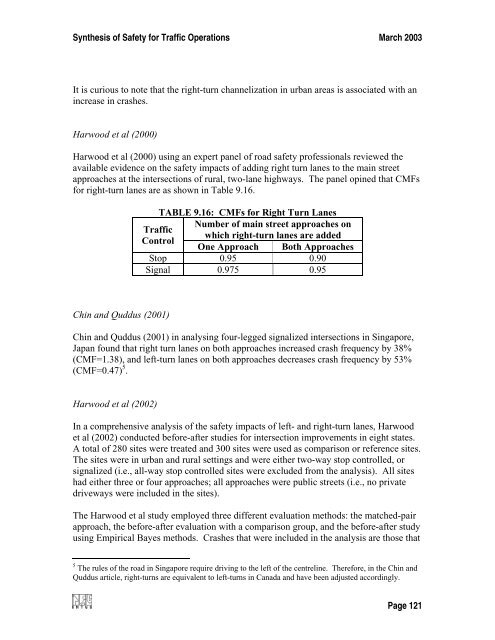Synthesis of Safety for Traffic Operations - Transports Canada
Synthesis of Safety for Traffic Operations - Transports Canada
Synthesis of Safety for Traffic Operations - Transports Canada
Create successful ePaper yourself
Turn your PDF publications into a flip-book with our unique Google optimized e-Paper software.
<strong>Synthesis</strong> <strong>of</strong> <strong>Safety</strong> <strong>for</strong> <strong>Traffic</strong> <strong>Operations</strong> March 2003<br />
It is curious to note that the right-turn channelization in urban areas is associated with an<br />
increase in crashes.<br />
Harwood et al (2000)<br />
Harwood et al (2000) using an expert panel <strong>of</strong> road safety pr<strong>of</strong>essionals reviewed the<br />
available evidence on the safety impacts <strong>of</strong> adding right turn lanes to the main street<br />
approaches at the intersections <strong>of</strong> rural, two-lane highways. The panel opined that CMFs<br />
<strong>for</strong> right-turn lanes are as shown in Table 9.16.<br />
TABLE 9.16: CMFs <strong>for</strong> Right Turn Lanes<br />
Number <strong>of</strong> main street approaches on<br />
<strong>Traffic</strong><br />
which right-turn lanes are added<br />
Control<br />
One Approach Both Approaches<br />
Stop 0.95 0.90<br />
Signal 0.975 0.95<br />
Chin and Quddus (2001)<br />
Chin and Quddus (2001) in analysing four-legged signalized intersections in Singapore,<br />
Japan found that right turn lanes on both approaches increased crash frequency by 38%<br />
(CMF=1.38), and left-turn lanes on both approaches decreases crash frequency by 53%<br />
(CMF=0.47) 5 .<br />
Harwood et al (2002)<br />
In a comprehensive analysis <strong>of</strong> the safety impacts <strong>of</strong> left- and right-turn lanes, Harwood<br />
et al (2002) conducted be<strong>for</strong>e-after studies <strong>for</strong> intersection improvements in eight states.<br />
A total <strong>of</strong> 280 sites were treated and 300 sites were used as comparison or reference sites.<br />
The sites were in urban and rural settings and were either two-way stop controlled, or<br />
signalized (i.e., all-way stop controlled sites were excluded from the analysis). All sites<br />
had either three or four approaches; all approaches were public streets (i.e., no private<br />
driveways were included in the sites).<br />
The Harwood et al study employed three different evaluation methods: the matched-pair<br />
approach, the be<strong>for</strong>e-after evaluation with a comparison group, and the be<strong>for</strong>e-after study<br />
using Empirical Bayes methods. Crashes that were included in the analysis are those that<br />
5 The rules <strong>of</strong> the road in Singapore require driving to the left <strong>of</strong> the centreline. There<strong>for</strong>e, in the Chin and<br />
Quddus article, right-turns are equivalent to left-turns in <strong>Canada</strong> and have been adjusted accordingly.<br />
Page 121
















